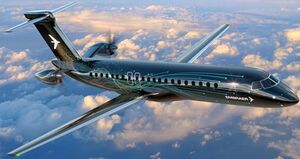Embraer next-generation turboprop
Topic: Engineering
 From HandWiki - Reading time: 2 min
From HandWiki - Reading time: 2 min
| Next-generation turboprop | |
|---|---|

| |
| Updated configuration with aft engines, released in August 2021. | |
| Role | regional airliner |
| Manufacturer | Embraer |
| Introduction | planned 2027/2028[1] |
| Status | Prototype |
| Developed from | Embraer E-Jet |
The Next-generation turboprop is a regional airliner concept proposed by Embraer, powered by turboprop engines.
Development
By May 2019, Embraer was considering developing a new family of turboprop regional airliners in the 50–70 seat range, complementing the E-Jet E2, so as to free engineering resources.[2][3] By July 2020, it had evolved into the 70–100 passenger range[4] In October 2020, Embraer released conceptual depictions of the 75–90 seat airliner, with a fuselage similar to the E-Jet and turboprops above a low wing but a different T-tail design. It would compete against older ATR and Dash 8 designs for 1.5 to 2 h flights over 500–700 nmi (930–1,300 km).[5]
In August 2021, Embraer released a new configuration with quieter aft-mounted engines for a 70-90 seat aircraft, with the E-Jet cross-section, aiming for a 2022 launch and a 2027/2028 service entry.[1] Over a 250 nmi (460 km) sector, a 74-seat TPNG 70 would burn 5% less fuel than a 70-seat ATR-72 and 13% less than the 80-seat Dash 8-400; while the 90-seat TPNG would save 18% per seat compared with the ATR, and 25% compared with the Dash.[6] Embraer forecasts a market for 2,260 turboprops in the two decades following 2022.[7]
See also
Related development
Aircraft of comparable role, configuration and era
Related lists
References
- ↑ 1.0 1.1 Jon Hemmerdinger (13 August 2021). "Embraer tweaks turboprop concept to have aft-mounted engines". Flightglobal. https://www.flightglobal.com/airframers/embraer-tweaks-turboprop-concept-to-have-aft-mounted-engines/145078.article.(Subscription content?)
- ↑ Hemmerdinger, Jon (14 November 2019). "Embraer still eyeing development of turboprop family". Flightglobal. https://www.flightglobal.com/news/articles/embraer-still-eyeing-development-of-turboprop-famil-462231/.(Subscription content?)
- ↑ "No new turboprop from Embraer for now". Leeham News and Analysis. 27 May 2019. https://leehamnews.com/2019/05/27/no-new-turboprop-from-embraer-for-now/.
- ↑ Viana, Pedro, "Embraer revela mais detalhes sobre seu novo projeto de avião turboélice" (in PT), Aero flap, https://www.aeroflap.com.br/embraer-revela-mais-detalhes-sobre-seu-novo-projeto-de-aviao-turboelice/, retrieved 22 July 2020
- ↑ Jon Hemmerdinger (29 October 2020). "Embraer tweets picture of conceptual turboprop, hints at potential design". Flightglobal. https://www.flightglobal.com/airframers/embraer-tweets-picture-of-conceptual-turboprop-hints-at-potential-design/140876.article.(Subscription content?)
- ↑ Scott Hamilton (Oct 25, 2021). "Pontifications: Engines drive timing of new Embraer TPNG". Leeham News. https://leehamnews.com/2021/10/25/pontifications-engines-drive-timing-of-new-embraer-tpng/.
- ↑ Greg Waldron (15 February 2022). "Embraer spins up turboprop ambitions". Flightglobal. https://www.flightglobal.com/singapore-2022/embraer-spins-up-turboprop-ambitions/147516.article.
 |
 KSF
KSF